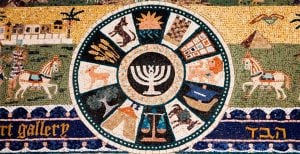The City of David is the original hilltop upon which King David dedicated ancient Jerusalem as his capital 3,000 years ago. Today, the City of David is revealing some of the most exciting archeological finds of the ancient world, providing fascinating pieces to the puzzle of life in ancient Jerusalem. Here are the top 10 discoveries ever made at the City of David in Jerusalem:
1) Hezekiah’s Tunnel: A stunning work of ancient engineering, covering a distance 1,500 feet, this tunnel was dug underneath the City of David by King Hezekiah in 701 BCE to protect Jerusalem’s water source, the Gihon Spring, from the invading Assyrians (2 Chron. 32:2-4). It is one of the few surviving structures mentioned in the Bible.
2) Walls of Jerusalem: Extensive excavations on Mount Zion have uncovered the amazing remains of an ancient wall of Jerusalem from the Second Temple period (second century BCE – 70 CE) and those of a city wall from the Byzantine period (324-640 CE) which was built on top of it.
3) The Shiloh Pool: A magnificent structure constructed 2,000 years ago during the days of King Herod which served as an central meeting point for Jerusalem’s pilgrims who would arrive in the city to visit the Temple Mount on the three major Jewish holidays, Passover, the Feast of Tabernacles (Sukkot), and the Festival of Weeks (Shavuot).
4) Herodian Road: This pathway once connected the Shiloh Pool to the Temple Mount and served as the main passageway for all of Jerusalem’s pilgrims and visitors. Shops and businesses once lined this ancient highway for the vast exposure to the many pilgrims who filled Jerusalem on the holidays.
5) Warren’s Shaft: A secret access tunnel that led from the city deep into the mountain through a 13-meter shaft, it was used by the ancient Jerusalemites to draw their water from the Gihon Spring.
6) Royal Palace: In December 2007, the Israeli Antiquities Authority uncovered an edifice in the City of David thought to be from the Second Temple period and belonging to the family of Queen Helena of Adiabene.
7) National Coins: Among the finds recently recovered are coins that date to the end of the Second Temple period and the end of the Great Revolt against the Romans in 69-70 CE.
8) Ancient Jewelry: Recent excavations also include 2,000-year-old gold earrings and other royal jewelry.
9) Judicial Administration: A preserved 2,600 year old clay seal with the name Gedaliah ben Pashur was discovered in the summer of 2008. The name appears in the Book of Jeremiah (38:1) as a minister in the court of King Zedekiah, the last king to rule in Jerusalem before the destruction of the First Temple.
10) Legal Documents: Israel Antiquities Authority archaeologists excavated a 1,700-year-old curse tablet from a Roman mansion in the City of David in Jerusalem.






